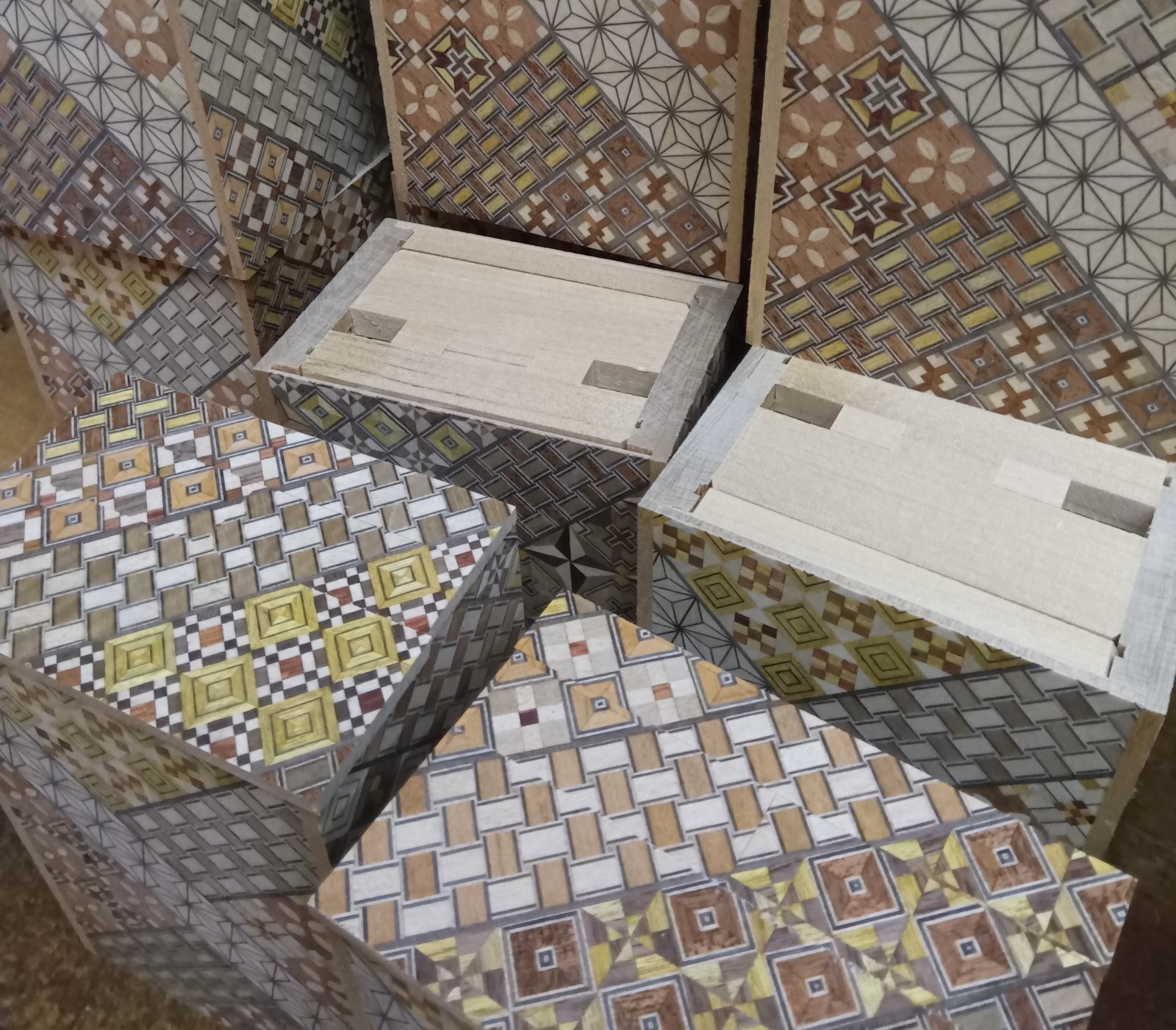Attaching the Two sliding-key panels

The stretch of good weather we had for the past few days has ended, and this morning started with a cloudy sky. In the afternoon, the rain has been coming and going. The temperature has dropped as well, and now it’s hard to stay warm without heating. In this weather, I worked on attaching the sliding-key (kannuki) panels of the 36-steps puzzle box. Since I had a little extra time yesterday, I finished making the panel parts in advance. Today, I attached the small internal wooden pieces, prepared the gluing surfaces of the box, and then attached the panels in the afternoon.
These sliding-key panels are different from normal panels because they are divided into four pieces. Normally, there are only three pieces. In a regular panel, one sliding key is attached to a single panel. But in this type, that one sliding key is split in the middle so it can move to the left and right. Because of that, the panel is divided into four parts. To make it, I first create a normal three-part panel, and at the end I cut the sliding key evenly in the center. With a three-part sliding key, the key can be pushed from the end, so it is easier to move—you can push it from behind. But with this divided sliding key, you have to move it from the center, which makes it harder. You need to push it slightly downward as you press, which makes it even more difficult. So when attaching this panel, the most important thing to check is how stiff the key movement is. This stiffness depends on how to the small internal wooden piece is fitted. Since the key and the wooden piece are linked, if the wooden piece is fitted too tightly, the already hard-to-move sliding key will become very difficult to move. Because of this, I need to be extra careful when attaching the internal wooden pieces for the 36-steps mechanism. I must avoid making them too loose, but also make sure they are not as tight as the ones used in other boxes.
When attaching the panels, all four divided parts must be glued at the same time. The small wooden pieces are tiny, and their positions are very precise, so I need to work quickly. Also, unlike the three-part type, the position of the wooden pieces cannot be adjusted later, so I must carefully check that each piece returns to its original position and fits correctly when I attach the panels. When flattening the surface of the box, the small wooden pieces can sometimes shift slightly from the machine’s vibration, so I always have to make sure they are seated in the right place before gluing.
It was raining a little, but on the first day when the rain starts, the humidity is not very high yet. The humidity begins to rise the next day, when the ground absorbs the moisture. That’s why people often say that the humidity is higher on the day after the rain stops than on the actual rainy day. This week, it looks like the hexagonal boxes for Hakone Market and the 5-sun 36-steps box will both be finished.
These sliding-key panels are different from normal panels because they are divided into four pieces. Normally, there are only three pieces. In a regular panel, one sliding key is attached to a single panel. But in this type, that one sliding key is split in the middle so it can move to the left and right. Because of that, the panel is divided into four parts. To make it, I first create a normal three-part panel, and at the end I cut the sliding key evenly in the center. With a three-part sliding key, the key can be pushed from the end, so it is easier to move—you can push it from behind. But with this divided sliding key, you have to move it from the center, which makes it harder. You need to push it slightly downward as you press, which makes it even more difficult. So when attaching this panel, the most important thing to check is how stiff the key movement is. This stiffness depends on how to the small internal wooden piece is fitted. Since the key and the wooden piece are linked, if the wooden piece is fitted too tightly, the already hard-to-move sliding key will become very difficult to move. Because of this, I need to be extra careful when attaching the internal wooden pieces for the 36-steps mechanism. I must avoid making them too loose, but also make sure they are not as tight as the ones used in other boxes.
When attaching the panels, all four divided parts must be glued at the same time. The small wooden pieces are tiny, and their positions are very precise, so I need to work quickly. Also, unlike the three-part type, the position of the wooden pieces cannot be adjusted later, so I must carefully check that each piece returns to its original position and fits correctly when I attach the panels. When flattening the surface of the box, the small wooden pieces can sometimes shift slightly from the machine’s vibration, so I always have to make sure they are seated in the right place before gluing.
It was raining a little, but on the first day when the rain starts, the humidity is not very high yet. The humidity begins to rise the next day, when the ground absorbs the moisture. That’s why people often say that the humidity is higher on the day after the rain stops than on the actual rainy day. This week, it looks like the hexagonal boxes for Hakone Market and the 5-sun 36-steps box will both be finished.